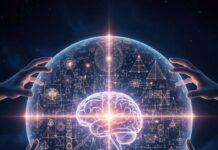In recent years, artificial intelligence (AI) has moved from laboratories and universities to the center of public discourse. Tools like ChatGPT and Gemini have transformed the way we work, learn, and explore our creativity. But this revolution did not emerge out of nowhere—it is the result of more than seven decades of scientific research, technical advances, and accumulated learning.
To better understand this moment and its implications, Ciencia del Sur interviewed Vasileios Maroulas, professor at the University of Tennessee, director of the AI Tennessee initiative, and a leading researcher in computational statistics, geometry, and machine learning. Prof. Maroulas visited Paraguay a few weeks ago to deliver a series of conferences.
Vasileios Maroulas currently serves as Associate Vice Chancellor for Research, Innovation, and Economic Development, and director of the AI Tennessee initiative at the University of Tennessee, Knoxville. He is also a mathematics professor with joint appointments in statistics, business analytics, and data Engineering.
He leads an ambitious state-level effort to position Tennessee as a national hub for innovation and talent development in AI, connecting universities, industry, national laboratories, and government agencies.
His research spans computational statistics, machine learning, applied probability, computational geometry, and quantum data science, with applications in defense, health, biology, chemistry, and neuroscience. He has received continuous funding from federal agencies, laboratories, and prestigious foundations, and holds editorial positions in leading international journals. With a PhD in Statistics from UNC Chapel Hill and postdoctoral fellowship at the Institute for Mathematics and its Applications at the University of Minessota, he combines academic excellence, strategic leadership, and interdisciplinary collaboration to drive technological and economic transformation.
In this interview, he analyzes the true scope of the AI revolution, the ethical and educational challenges it poses, the opportunities for developing countries like Paraguay, and the transformative potential of the synergy between artificial intelligence and quantum computing.
-Today, everyone is talking about artificial intelligence, and there are even numerous AI courses and workshops. Are we really experiencing an “AI revolution” or is it more of a pre-tech evolution stage?
We are indeed in the midst of an AI revolution that it did not arrive suddenly. What appears today as a breakthrough moment is the result of over 70 years of persistent research, development, and setbacks. The term AI was coined in 1955 by John McCarthy, a mathematician and computer scientist. Since then, AI has passed through multiple eras, early optimism, disillusionment (the so-called «AI winters»), and major advances. But until recently, AI’s impact remained mostly confined to labs and niche applications.
That changed in late 2022 with the public release of tools like OpenAI’s ChatGPT. For the first time, millions experienced AI in their daily lives, writing, coding, analyzing, being creative, and learning with machine assistance. This moment marked the mainstreaming of AI. What we are witnessing now is not the start of the AI journey but its arrival at a tipping point. We are living through a workforce and societal transformation powered by AI, one that is reshaping industries, redefining roles, and accelerating human potential.
-Why are so many people afraid of AI replacing humans in jobs, art, or other sectors?
AI is not going to replace jobs, certainly not human judgement. Workers who do not use AI for data-driven decision-making will simply be replaced by those who do. AI reveals patterns and insights that often escape human attention, and those who take advantage of this will gain a decisive edge. These concerns are not new.
Since the inception of AI, questions like “Can machines think?” or “Will machines govern us?” have captured human imagination and anxiety. What is different now is that AI amplifies human capabilities not only in the physical realm (like the car or hammer once did), but in the mental and cognitive realm.
Today, in the vast majority of jobs, AI functions as a tool to cut through tedious processes, reduce time spent on routine tasks, and free people to focus on more meaningful contributions. This opens a unique opportunity to lifelong learners who have an immense opportunity to upskill and strengthen their role in the workforce, while the new generation, growing up in the AI era, will naturally replace those who have not adapted to the new times.
-Is the United States leading the way in AI research and development, or do you see increasingly strong competition from Europe, China, or other countries?
The United States is unquestionably the leading country in AI research and development. In 2024 alone, US institutions and companies produced more than 40 new AI models, compared to 15 in China and only 3 in Europe. This reflects not just scale, but also the depth and diversity of American AI innovation.
Three pillars sustain US leadership:
- Industry: US companies are investing at an unprecedented pace, driving a rapid workforce transformation and embedding AI across every sector.
- Academia: US universities generate highly citable, world-class research that advances both foundational and applied AI.
- Government: Federal funding initiatives have catalyzed innovation, while state governments are moving aggressively to implement AI solutions.
Some states are emerging as AI leaders in their own right. For example, AI Tennessee, a statewide initiative led by the University of Tennessee, Knoxville, is strategically positioning Tennessee as a global player in the data economy by leveraging its strengths in energy, manufacturing, agriculture, and other vital sectors. Together, these forces ensure that the U.S. not only leads the global AI race today but also builds the ecosystem to sustain that leadership in the years ahead.
-Colleges, schools, and universities are still unsure about how to respond when their students use AI tools in assignments and exams. What is your advice to educational institutions?
AI should be viewed as essential infrastructure for education, not as a threat. The classroom today looks surprisingly similar to what it did 50 years ago, still shaped by industrial-era models, while we now live in an era of digital transformation. Rather than resisting, educational institutions should embed AI into the curriculum and daily practices of teaching.
For educators, AI can relieve the burden of repetitive tasks such as grading or scheduling, allowing them to focus on what truly matters: mentoring, leadership, and fostering creativity. This moment presents a unique opportunity for policymakers and institutions to rethink education at its core. With AI as an enabler, we can return to a more Socratic model of learning, dialogue-driven, student-centered, and focused on cultivating wisdom rather than simply measuring performance.
-Your research combines computational statistics, geometry, and machine learning. How do these disciplines integrate to address complex problems in biology, defense, or neuroscience?
These fields come together as different lenses on the same problem. Computational statistics helps us quantify uncertainty, geometry captures the structure and shape of complex data, and machine learning provides the tools to learn patterns at scale.
When integrated, they allow us to model systems that are too intricate for any single approach, such as neural circuits in the brain, decision-making in defense applications, or molecular interactions in biology. The goal is to create methods that are both mathematically rigorous and practically useful, turning abstract data into actionable insight.
-What should be the ethical and regulatory priorities to ensure the responsible development of AI? How should governments legislate it?
The priority for governments is not to slow AI with regulation but to guide it so innovation flourishes responsibly. That means three things:
1.removing barriers that hold back research and development,
- investing in the infrastructure AI depends on, e.g., data, computing, energy, and workforce, and
- establishing clear standards that build trust and accountability.
Ethical and regulatory frameworks should focus on enabling safe and productive uses of AI, while protecting against misuse. The goal is to ensure that AI strengthens competitiveness, supports human creativity, and advances democratic values rather than systems of control.
-Which productive sectors will benefit most from AI in the short term, and which could be displaced?
In the short term, AI will deliver the greatest benefits in sectors that are data-intensive and process-heavy, e.g., manufacturing, logistics, healthcare, agriculture, and energy, where AI can optimize operations, reduce waste, accelerate discovery, and improve decision-making.
Knowledge work fields such as finance, business services, and education will also see major efficiency gains. The sectors most at risk of displacement are those built on repetitive, routine tasks, like clerical work, basic customer service, and certain administrative roles. But even here, AI is less about wholesale replacement and more about reshaping jobs, tasks are automated, while the human role shifts toward oversight, interpretation, and creativity. In other words, AI changes the nature of jobs, amplifying productivity for those who adapt, and displacing only those functions that fail to evolve.
-You have applied your methods to neuroscience and health. What specific advances in diagnosis or treatment do you think AI will make possible in the next five years?
In the near term, AI will impact both diagnosis and personalization. On the diagnostic side, AI can detect subtle patterns in scans, x-rays, genetic data, or clinical records that humans often miss, allowing earlier identification of conditions such as Alzheimer’s, Parkinson’s, or certain cancers.
On the treatment side, AI will accelerate precision medicine, matching therapies to the biology of each patient. We will also see advances in digital biomarkers and real-time monitoring, where wearable devices and AI models track changes in health continuously and trigger timely interventions.
The broader impact is a shift from reactive to proactive healthcare, where diseases are caught earlier, treatments are better targeted, and patients play a more active role in managing their health.
-What specific objectives does the AI Tennessee initiative pursue, and how could it serve as a model for other states or developing countries?
AI Tennessee turns vision into impact by aligning five pillars into a unified strategy: research, education, infrastructure, partnerships, and outreach. Research drives innovation; education prepares the workforce; infrastructure builds the backbone of data and energy; partnerships connect universities, industry, and government; and outreach ensures AI benefits all communities.
Our approach is sector-driven, targeting areas where policy alignment delivers the greatest impact: manufacturing for competitiveness, agriculture for food security, energy for sustainability, health for access, and workforce programs for reskilling. The model is transferable.
Any region can start by anchoring AI in its natural strengths, whether agriculture, energy, or human talent, and building outward. That way, AI is not just a technology, but a policy framework for national growth and societal benefit.
-You also research quantum data science. What is the real potential of combining AI with quantum computing?
The relationship between AI and quantum computing is two-way, and this where the real potential exists. On one hand, AI for quantum means using machine learning to translate, optimize, and even discover new quantum algorithms. Because quantum systems are complex, AI can help us design more efficient circuits, correct errors, and accelerate the development of quantum software.
On the other side, quantum for AI opens the possibility of solving problems that are currently out of reach. Quantum computing could handle the enormous combinatorial challenges in optimization, drug discovery, or materials science. Quantum materials themselves are another frontier, where AI can help us model and design the materials that will one day power scalable quantum computers.
The long-term vision is a feedback loop: AI accelerates quantum discovery, quantum accelerates AI capabilities, and together they unlock advances in science, technology, and industry that neither could achieve alone.
-Based on your international experience, what strategies would you recommend to Latin American countries, including Paraguay, to promote sustainable research and development of artificial intelligence?
The starting point is to view AI as infrastructure for development, not just as a new technology. That means investing in research and education, building modern digital and energy systems, fostering partnerships across government, universities, and industry, and engaging society so AI is trusted and broadly adopted. For Paraguay, there is a clear opportunity to align AI with its unique strengths, agriculture, energy, and young talented workforce.
By embedding AI into these areas, the country can build competitive advantage, strengthen its economy, and ensure innovation translates into broad social benefits. The strategy overall is simple: anchor AI in what a country already does well, and then scale outward through education, partnerships, and infrastructure. That’s how AI becomes not just a tool but a driver of sustainable national growth.
¿Qué te pareció este artículo?
Director ejecutivo de Ciencia del Sur y presidente de Ciencia del Sur EAS. Estudió filosofía en la Universidad Nacional de Asunción (UNA) y pasó por el programa de Jóvenes Investigadores de la UNA. Tiene diplomados en filosofía medieval (Universidad Iberoamericana) y en relaciones internacionales (Universidad Interamericana). Se especializó en filosofía científica (Universidad Nacional de la Plata) y en museología (Universidad Autónoma de Asunción).
Condujo los programas de radio El Laboratorio, con temática científica (Ñandutí) y ÁgoraRadio, de filosofía (Ondas Ayvu).
Fue periodista, columnista y editor de Ciencia y Tecnología en el diario ABC Color y colaboró con publicaciones internacionales. Fue presidente de la Asociación Paraguaya Racionalista, secretario del Centro de Difusión e Investigación Astronómica y encargado de cultura científica de la Universidad Iberoamericana.
Periodista de Ciencia del Año por el Consejo Nacional de Ciencia y Tecnología (2017). Tiene cinco libros publicados. También es director de MUPA: Voces de Museos y Patrimonios.











